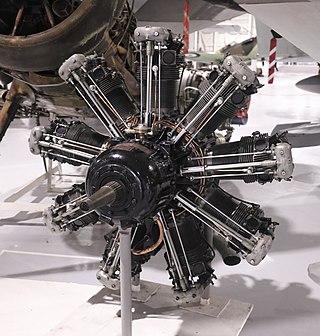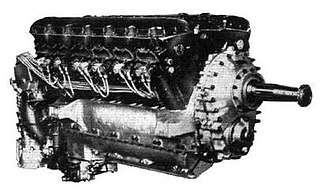
The Rolls-Royce Merlin is a British liquid-cooled V-12 piston aero engine of 27-litre capacity. Rolls-Royce designed the engine and first ran it in 1933 as a private venture. Initially known as the PV-12, it was later called Merlin following the company convention of naming its four-stroke piston aero engines after birds of prey. The engine benefitted from the racing experiences of precursor engines in the 1930s.

A PT boat was a motor torpedo boat used by the United States Navy in World War II. It was small, fast, and inexpensive to build, valued for its maneuverability and speed but hampered at the beginning of the war by ineffective torpedoes, limited armament, and comparatively fragile construction that limited some of the variants to coastal waters. In the US Navy they were organized in Motor Torpedo Boat Squadrons (MTBRONs).

The Bristol Jupiter is a British nine-cylinder single-row piston radial engine that was built by the Bristol Aeroplane Company. Originally designed late in World War I and known as the Cosmos Jupiter, a lengthy series of upgrades and developments turned it into one of the finest engines of its era.

The Centaurus was the final development of the Bristol Engine Company's series of sleeve valve radial aircraft engines. The Centaurus is an 18-cylinder, two-row design that eventually delivered over 3,000 hp (2,200 kW). The engine was introduced into service late in the Second World War and was one of the most powerful aircraft piston engines to see service.

The Curtiss Falcon was a family of military biplane aircraft built by the American aircraft manufacturer Curtiss Aeroplane and Motor Company during the 1920s. Most saw service as part of the United States Army Air Corps as observation aircraft with the designations O-1 and O-11, or as the attack aircraft designated the A-3 Falcon.

The Mitsubishi Kasei was a two-row, 14-cylinder air-cooled radial engine built by Mitsubishi Heavy Industries and used in a variety of World War II Japanese aircraft, such as Mitsubishi J2M and Mitsubishi G4M. The Mitsubishi model designation for this engine was A10 while it was an experimental project, in service it was known as the MK4, and known as the Ha101 & Ha111 by the Army and Kasei by the Navy. According to unified designation code it was Ha-32 of the variants from 11 to 27.

The Packard V-1650 Merlin is a version of the Rolls-Royce Merlin aircraft engine, produced under license in the United States by the Packard Motor Car Company. The engine was licensed to expand production of the Rolls-Royce Merlin for British use. The engine also filled a gap in the U.S. at a time when similarly powered American-made engines were not available.

The Liberty L-12 is an American water-cooled 45° V-12 aircraft engine displacing 1,649 cubic inches (27 L) and making 400 hp (300 kW) designed for a high power-to-weight ratio and ease of mass production. It saw wide use in aero applications, and saw marine use both in racing and runabout boats once it was marinized.

The Rolls-Royce Goshawk was a development of the Rolls-Royce Kestrel that used evaporative or steam cooling. In line with Rolls-Royce convention of naming piston engines after birds of prey, it was named after the goshawk.

The Boeing Model 15 is a United States single-seat open-cockpit biplane fighter aircraft of the 1920s, manufactured by the Boeing company. The Model 15 saw service with the United States Army Air Service and with the United States Navy as a carrier-based fighter.

The Boeing XP-4 was a prototype American biplane fighter of the 1920s. It was grounded permanently after just 4.5 hours of flight testing.

The Alvis Leonides is a British air-cooled nine-cylinder radial aero engine first developed by Alvis Car and Engineering Company in 1936.
The Mitsubishi Kinsei was a 14-cylinder, air-cooled, twin-row radial aircraft engine developed by Mitsubishi Heavy Industries in Japan in 1934 for the Imperial Japanese Navy. The Mitsubishi model designation for this engine was A8 while it was an experimental project; in service, it was known as the MK8 "Kinsei" by the Navy. In 1941 the engine was adopted by Army, receiving designation Ha-112. In May 1943 it received Ha-33 unified designation code.
The Packard 1A-1500 was an American 12-cylinder liquid-cooled 60-degree Vee piston aircraft engine designed in 1924. Test flown in the second prototype Douglas XO-2, it proved to be unreliable. Only 29 engines were built.

The Naval Aircraft Factory PN was a series of open cockpit American flying boats of the 1920s and 1930s. A development of the Felixstowe F5L flying boat of the World War I, variants of the PN were built for the United States Navy by Douglas, Keystone and Martin.

The Huff-Daland LB-1 was an American biplane light bomber aircraft operated by the United States Army Air Service in the 1920s.

The Martin T3M was an American torpedo bomber of the 1920s. A single-engined three-seat biplane, it became a standard torpedo bomber of the U.S. Navy, operating from both land bases and from aircraft carriers from 1926 to 1932.

The RAF 4 is a British air-cooled, V12 engine developed for aircraft use during World War I. Based on the eight–cylinder RAF 1 it was designed by the Royal Aircraft Factory but produced by the two British companies of Daimler and Siddeley-Deasy. The RAF 5 was a pusher version of the same engine.

The Packard X-2775 was an American experimental liquid-cooled aircraft engine. The engine was constructed as a single crankcase with four banks of six cylinders in what is close to an X-configuration. The engine consisted of two 60° V12 engines, one upright and one inverted, sharing a common crankcase. Although technically incorrect, the engine has been characterized as two Packard 1A-1500 V-12 engines coupled with a mutual crankcase.

Crash boats, at the time known as "aircraft rescue boats" or "air-sea rescue boats", were United States high speed boats built to rescue the crew of downed Allied aircraft during World War II. US boats came from the observation of British experience with high-speed launches (HSL) by the Royal Air Force Marine Branch during the Battle of Britain.


















